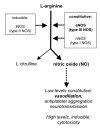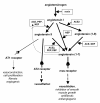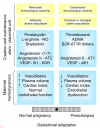Vasodilator factors in the systemic and local adaptations to pregnancy
- PMID: 19646248
- PMCID: PMC2739214
- DOI: 10.1186/1477-7827-7-79
Vasodilator factors in the systemic and local adaptations to pregnancy
Abstract
We postulate that an orchestrated network composed of various vasodilatory systems participates in the systemic and local hemodynamic adaptations in pregnancy. The temporal patterns of increase in the circulating and urinary levels of five vasodilator factors/systems, prostacyclin, nitric oxide, kallikrein, angiotensin-(1-7) and VEGF, in normal pregnant women and animals, as well as the changes observed in preeclamptic pregnancies support their functional role in maintaining normotension by opposing the vasoconstrictor systems. In addition, the expression of these vasodilators in the different trophoblastic subtypes in various species supports their role in the transformation of the uterine arteries. Moreover, their expression in the fetal endothelium and in the syncytiotrophoblast in humans, rats and guinea-pigs, favour their participation in maintaining the uteroplacental circulation. The findings that sustain the functional associations of the various vasodilators, and their participation by endocrine, paracrine and autocrine regulation of the systemic and local vasoactive changes of pregnancy are abundant and compelling. However, further elucidation of the role of the various players is hampered by methodological problems. Among these difficulties is the complexity of the interactions between the different factors, the likelihood that experimental alterations induced in one system may be compensated by the other players of the network, and the possibility that data obtained by manipulating single factors in vitro or in animal studies may be difficult to translate to the human. In addition, the impossibility of sampling the uteroplacental interface along normal pregnancy precludes obtaining longitudinal profiles of the various players. Nevertheless, the possibility of improving maternal blood pressure regulation, trophoblast invasion and uteroplacental flow by enhancing vasodilation (e.g. L-arginine, NO donors, VEGF transfection) deserves unravelling the intricate association of vasoactive factors and the systemic and local adaptations to pregnancy.
Figures









Similar articles
-
Vasoactive and permeability effects of vascular endothelial growth factor-165 in the term in vitro dually perfused human placental lobule.Endocrinology. 2007 Oct;148(10):4734-44. doi: 10.1210/en.2007-0180. Epub 2007 Jul 19. Endocrinology. 2007. PMID: 17640983
-
Pregnancy-associated increase in rat systemic arteries endothelial nitric oxide production diminishes vasoconstrictor but does not enhance vasodilator responses.Life Sci. 2002 May 17;70(26):3131-42. doi: 10.1016/s0024-3205(02)01576-x. Life Sci. 2002. PMID: 12008096
-
Distribution of angiotensin-(1-7) and ACE2 in human placentas of normal and pathological pregnancies.Placenta. 2006 Feb-Mar;27(2-3):200-7. doi: 10.1016/j.placenta.2005.02.015. Epub 2005 Apr 25. Placenta. 2006. PMID: 16338465
-
The Croonian Lecture, 1993. The endothelium: maestro of the blood circulation.Philos Trans R Soc Lond B Biol Sci. 1994 Jan 29;343(1304):225-46. doi: 10.1098/rstb.1994.0023. Philos Trans R Soc Lond B Biol Sci. 1994. PMID: 8146236 Review.
-
G-Protein-coupled receptors as potential drug candidates in preeclampsia: targeting the relaxin/insulin-like family peptide receptor 1 for treatment and prevention.Hum Reprod Update. 2016 Sep;22(5):647-64. doi: 10.1093/humupd/dmw021. Epub 2016 Jul 6. Hum Reprod Update. 2016. PMID: 27385360 Free PMC article. Review.
Cited by
-
Restoring placental growth factor-soluble fms-like tyrosine kinase-1 balance reverses vascular hyper-reactivity and hypertension in pregnancy.Am J Physiol Regul Integr Comp Physiol. 2016 Sep 1;311(3):R505-21. doi: 10.1152/ajpregu.00137.2016. Epub 2016 Jun 8. Am J Physiol Regul Integr Comp Physiol. 2016. PMID: 27280428 Free PMC article.
-
Estrogen-related receptor γ (ERRγ) regulates oxygen-dependent expression of voltage-gated potassium (K+) channels and tissue kallikrein during human trophoblast differentiation.Mol Endocrinol. 2013 Jun;27(6):940-52. doi: 10.1210/me.2013-1038. Epub 2013 Apr 12. Mol Endocrinol. 2013. PMID: 23584901 Free PMC article.
-
Bradykinin Sequestration by Plasmodium berghei Infected Erythrocytes Conditions B2R Signaling and Parasite Uptake by Fetal Trophoblasts.Front Microbiol. 2018 Dec 19;9:3106. doi: 10.3389/fmicb.2018.03106. eCollection 2018. Front Microbiol. 2018. PMID: 30619185 Free PMC article.
-
Utero-placental expression of angiotensin-(1-7) and ACE2 in the pregnant guinea-pig.Reprod Biol Endocrinol. 2013 Jan 22;11:5. doi: 10.1186/1477-7827-11-5. Reprod Biol Endocrinol. 2013. PMID: 23339712 Free PMC article.
-
Matrix metalloproteinases as drug targets in preeclampsia.Curr Drug Targets. 2013 Mar;14(3):325-34. doi: 10.2174/1389450111314030004. Curr Drug Targets. 2013. PMID: 23316964 Free PMC article. Review.
References
-
- Kaufmann P, Black S, Huppertz B. Endovascular trophoblast invasion: implications for the pathogenesis of intrauterine growth retardation and preeclampsia. Biol Reprod. 2003;69:1–7. - PubMed
-
- Kaufmann P, Mayhew TM, Charnock-Jones DS. Aspects of human fetoplacental vasculogenesis and angiogenesis. II. Changes during normal pregnancy. Placenta. 2004;25:114–126. - PubMed
-
- Reynolds LP, Redmer DA. Angiogenesis in the placenta. Biol Reprod. 2001;64:1033–1040. - PubMed
-
- Hytten F. Blood volume changes in normal pregnancy. Clin Haematol. 1985;14:601–612. - PubMed
Publication types
MeSH terms
Substances
LinkOut - more resources
Full Text Sources

